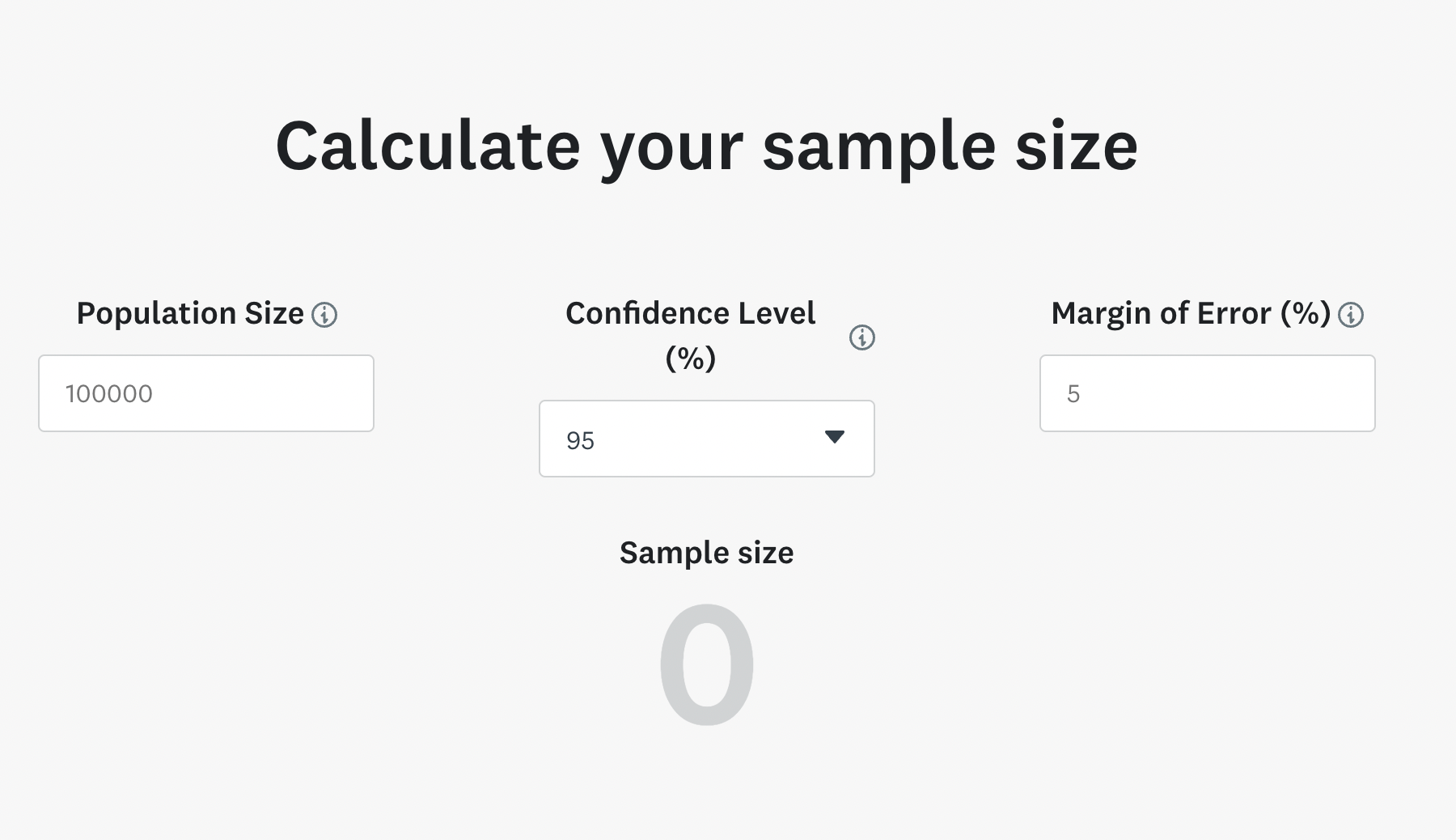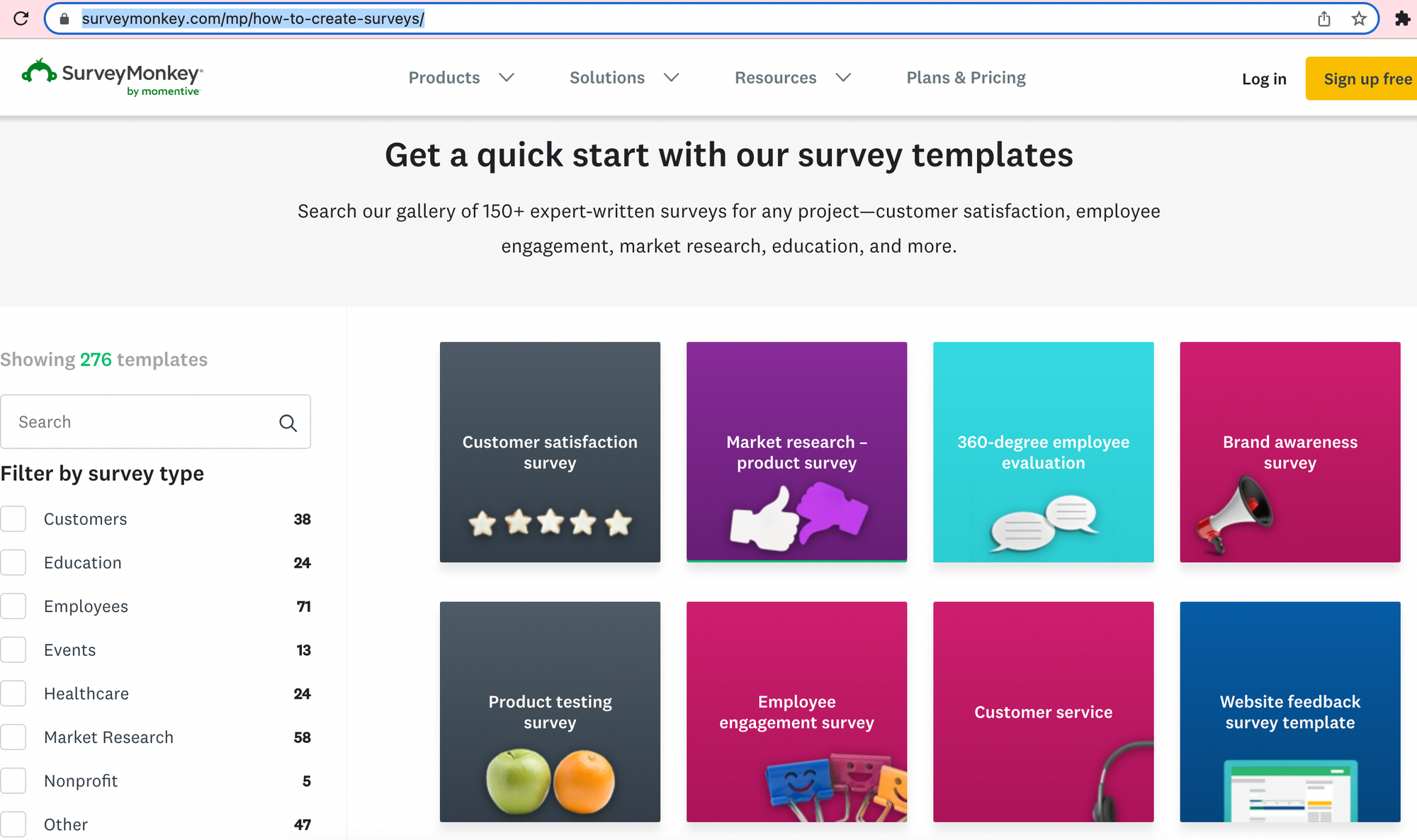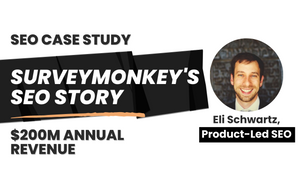Eli Schwartz joined SurveyMonkey in 2012. They’d been around a while and had venture funding, but had never invested in SEO.
In Eli’s own words:
“They were visible on the word survey. They were visible on the brand. But they were available in 16 languages, but weren't visible in any of those languages because they did not use serverside redirects on language pages. None of these pages were indexed. The survey pages, nothing. Their links were a mess...When I started there wasn't even a blog.”—Eli Schwartz, How the F*ck SEO Podcast
During his 7 years at the company, Eli developed and implemented his approach to search strategy: Product-Led SEO (get the book here).
A typical approach to SEO strategy might be to focus on middle and bottom-of-funnel keywords like “best survey makers” and “survey maker”—and to build topical clusters around those.
Of course, SurveyMonkey pursued that opportunity.
But, Eli’s product-led SEO strategy tapped into an almost infinite source of search traffic: prospect problems.
His strategy:
- Delved into prospective buyer pain points from user data
- Matched those pain points to keywords in tools
- Built content products to solve & serve intent
- Built a growth funnel around new leads
“Instead, by really focusing on the problem that users want to solve and that users were looking for, we now had hundreds and thousands of potential possibilities of pages. By the time I left, we never even finished that entire roadmap.”—Eli Schwartz, How the F*ck Podcast
And the results of this approach speak for themselves:
"By the time I left, we were generating an average $200 million a year in revenue sourced from organic search. I was there for seven years. So easily a billion dollars in revenue came from an organic channel [attributed]. Even though it is a SaaS B2B, most of the users behave like consumers. They pay for it on their own credit card and they expense it. Yes, they're using it at work, but it was cheap enough that they could just do it. Organic was the biggest driver of all growth.”—Eli Schwartz, How the F*ck Podcast
In this week’s SEO case study, we look at:
- What is product-led SEO?
- How did SurveyMonkey do product-led SEO?
- Other areas of content growth
- SurveyMonkey’s buyer funnel and creating the $200M annual revenue opportunity
- 3 examples of product-led SEO
Let’s dive in.
A Note on Branded Searches
The best available sources (below in Semrush), show SurveyMonkey to have between 1.5M and 2.5M monthly search visitors on average.
SurveyMonkey is a globally well-known brand. As expected, keyword tools show around 0.6M monthly searches come from brand searches.
It's worth noting that without great SEO, the website would not appear for branded searches.
However, for the rest of this case study, I’m going to focus on their content strategy for non-branded search traffic.
What is Product-Led SEO?
A typical SEO process would involve identifying keywords around your topic (“survey”), analyzing the SERPs for how to win it, and spending money to create content on that topic.
This process, as we all know, is expensive and doesn’t guarantee a ranking. Even then, that search term might not drive actual revenue results. In short, the ROI is not guaranteed.
Instead of keyword-driven SEO, product-led SEO focuses on the people or product that will be searched online.
To do that, you start with people:
- Look at your user data
- Analyze support calls
- Run a survey
Try to find out where the demand is:
- What content do your target customers want?
- What problems do they have that your product can solve?
“There are massive gaps for the kind of content people want online because too much of us are focused on writing content the keyword research tells us to write, rather than talking to people and asking them what they want.”—Eli Schwartz
When you know these things, you can build a “search product” (i.e. content that best serves the needs of the searcher) that’s truly effective.
Product-led SEO focuses you on creating content that will convert the reader, not just get traffic.
When you:
- Understand your customers
- Create SEO content for them and their needs
- Align your differentiation and core strategy with your SEO strategy
Then your visitors convert at a high rate, instead of a typical 0.001% rate.
Aim for Programmatic and Scalable Content
You know product-led SEO is really for you when you there is a programmatic solution to the problem facing your prospects.
Normal SEO: Let’s say I sell insurance. So look at Ahrefs keyword metrics and find something aligned. I write about that topic. I measure ranking and conversion rates from that content.
Product-led SEO: I ask, “What does the insurance buyer want and what are they looking for on the search engines?” I’m going to create a product around that. It might be a podcast, a widget, a video, or informational content. But there’s a thing the search user wants and I’m going to create it.
“Ideally, there’s a programmatic solution to that. Just look at TripAdvisor, Zillow, NerdWallet, stock price, and weather widgets. At its heart, it’s a product. Programmatic is a tactic to create that product at scale.”—Eli Schwartz, How the F*ck Podcast
How SurveyMonkey Did Product-Led SEO
When a user needs a survey, what they’re really looking for is to solve a problem.
For example, this might be their problem statement:
- I want to know why my employees are leaving.
- I want to know why my customers are churning.
- I want to know why my teachers are mad at me.
- I want to know why my students are mad at me.
To solve these problems, the SurveyMonkey team created templates to target each one.
Here’s the process:
Step 1: User data
During onboarding to the SurveyMonkey tool, users were asked the question “What’s the survey for?”.
Eli used that data to find out the most important customer pain points and prioritize which templates to create.
Step 2: Keyword research
“So I learned that one of the most common use cases was customer churn. So now understanding [customer satisfaction], I can do very specific keyword to research as a part of my research to understand which templates to create on [customer satisfaction]”—Eli Schwartz, How the F*ck Podcast
He notes that he first tried to get into the head of a person searching for a customer satisfaction survey. Who are they? What do they need to know?
Step 3: Template creation
He then created a page and template with the content and title tag on the topic of “customer churn survey template”.
Step 4: Programmatic solution
SurveyMonkey’s template library has 276 templates and they are nowhere near finished tapping into that opportunity.
Much like in the recent Typeform case study, each template page on-ramps the user into the product with a ready-to-go template.
By using their product, and keywords with a pattern “X template” they’re able to scale this approach much faster than creating long-form content each time.
These also back up into pages like their "free survey templates" page and others that funnel visitors toward the template library.
Other product-led SEO techniques used by SurveyMonkey
The specifics of these aren't mentioned in the episode, but I sifted through their site to find some more problem-focused search products.
1/ Mini tools
Something I think SurveyMonkey also does really well is its mini tools.
For example, their sample size calculator gets well over 30,000 monthly visitors.

There are 69 pages that receive an estimated 71,500 monthly visitors.

2/ How-to Content
Product-led SEO works by identifying specific user pain points and solving them. How-to content is a tell-tale sign of this.
SurveyMonkey's site has close to 700 pages with "how" in the URL, showing their focus on content that solves problems.

You'll also notice these pages align closely with their product strategy—and act as helpful guides around the "survey" topic.
These survey-related pages also funnel users towards the template library, by including the library at the bottom of the page.

Other Key Areas of Organic Growth
Undoubtedly, the template library used by SurveyMonkey was not their only organic traffic source. In fact, the template library itself is currently a tiny proportion of overall traffic.
However, when analyzing the site I found that other top pages funnel visitors to those templates as a conversion point.
For example, one top traffic page includes this page on “online polls” and generates well over 20,000 monthly visits.
This page ranks for 588 keywords in the top 3 SERPs on the topic of “poll maker” and “free online poll”.
This page acts like a hub page. It lists multiple templates in the library and refers the user to those to take action and sign-up.
Product-led SEO also means aligning your content and SEO strategy with your business. Almost all of SurveyMonkey’s top pages talk about surveys, forms, polls, and other use cases of the product.
This, combined with their template library, grabs a user and activates them.
Could this strategy actually create $200M in annual revenue?
The next section might help make sense of that number. My napkin maths is this:
- 1M monthly non-branded visitors. That's 12M visitors per year.
- Assumptive conversion rate 5%. That means 600,000 new customers a year.
- Their cheapest plan (the individual plan) is £384 a month.
- £384*600,000 = £203M
So, it's possible. Eli noted to me that the $200M organic figure comes from the site as a whole, including the homepage, but that before he joined there was nothing but the homepage existing.
As we learn in the next section, this was a joint effort by all marketing teams, not a pure SEO play.
SurveyMonkey’s Growth Funnel
Eli notes in the episode that their SEO strategy fit neatly into the buyer journey.
- SEO was top of the funnel. It found buyers with pain points and got them to sign up for the product for free.
- The paid team retargeted free visitors and users to encourage them to a paid account.
- The growth team sent upgrade triggers (e.g. offering more advanced premium templates and other features) to push a free user into a premium account.
- The CRM team sent organic leads an email 24 hours later to upsell premium features.
“So everyone's working together, and that's how we unlocked the 200 million a year in revenue. I'm not gonna take credit and say, well, they immediately went and did a search, and then they put their credit card in and done.”——Eli Schwartz, How the F*ck Podcast
3 Examples of Product-Led SEO
1/ Language Drops (Acquired by Kahoot!)
Drops is an app for learning languages. Their site gets over 200,000 organic visitors a month and is driven by programmatic pages.
Their users want to learn languages and commonly visit search engines to translate and learn words.
Their “visual dictionary” has tons of pages targeting terms like “How to say ‘X’ in ‘Y’ language”. Those pages are all interlinked in a large dictionary of terms across languages.
2/ Canva
Canva turned their product use cases into landing pages (71,000 landing pages) that capture over 70M in traffic.
For example, the search “desktop wallpaper templates” brings up the Canva product template library:
Which contains 13,000 user-generated templates:
The page is estimated to draw in +200,000 monthly visitors who can instantly become customers.
3/ Coinbase
Coinbase has built a currency converter product to fulfill search intent.
It receives over 1M estimated monthly traffic.
They also built a cryptocurrency “price” tracker, leveraging pricing data and a programmatic template.
They’ve got this page for 100s of cryptocurrencies. Together, 15,000 pages generate an estimated 2M monthly traffic.
With all of these examples, you can see how the pages closely align with the product and use scalable approaches to dominate those search terms.


